|
International Perspectives - October 11, 1999
Anne D. Picker
International Economist, Econoday
The central banks don't raise interest rates...
Five central banks met last week and none of them raised interest rates. The U.S. Federal Reserve, the Bank of England, the European Central Bank, the Swedish Riksbank and the Royal Bank of Australia all decided, for a variety of reasons not to change their key lending rates. The banks, with the exception of the Federal Reserve and Bank of England have not yet begun to reverse the interest rate cuts imposed during Asian/Russian crisis. With interest rate decisions made for now, the markets can turn their attention to third quarter earnings reports.
The Bank of England's Monetary Policy Committee decided not to raise interest rates. There was no explanation given. The Bank of England's major policy setting rate is 5.25 percent, the same as in the United States. Analysts were not surprised, but now expect a rate increase at the November meeting. The Bank of England has been under pressure from exporters and trade associations not to raise rates. They fear that higher interest rates will put a damper on the fledgling manufacturing recovery.
The European Central Bank also met and left rates unchanged. The markets had been expecting an increase, based on the improving German economy. The current ECB lending rate is 2.5 percent. Although the ECB meets again on October 21st, analysts think it is unlikely that rates will be raised before the November meetings.
Sweden's Riksbank voted to leave its repo rate unchanged at 2.9 percent. While the Bank indicated that a tightening move is not imminent, it hinted at a possible tightening of monetary policy in the medium term, saying demand growth is likely to be strong over the next two years. The Riksbank also introduced a procedural change. Now key interest rate decisions will be made only at its monetary policy meetings, which are held every six to eight weeks. The next monetary policy meeting is scheduled for November 11.
The Reserve Bank of Australia's Policy Making Board left benchmark rates unchanged, at 4.75 percent. Higher rates would increase the allure of the Australian dollar by narrowing the gap in investment return rates between Australia and the United States. Australia's benchmark rate on overnight loans is 4.75 percent, 50 basis points below that of the United States.
The Bank of Japan is the exception. Here the talk is about the need for continued easing - not tightening - of monetary policy. The Bank of Japan's Monetary Policy Board meets on Wednesday amid swirling rumors of the imminent departure of the Bank's governor Hayami. With the bank's main lending rate at near zero, cabinet members and politicians (along with the Group of Seven) are calling for monetary policy easing to prevent the yen from rising against the dollar. The rising yen could especially hurt exporters by making their products more expensive in the United States and Europe.
Japan's tankan survey is generally better than expected...
The Bank of Japan, in its tankan survey, reported that business confidence rose sharply in the last three months but that companies' plans for investment spending declined. Sentiment among large manufacturers had improved since the last survey and showed its biggest improvement since November 1987. The result exceeded analysts' expectations. But companies remain reluctant to translate that optimism into increased investment. That suggests that companies believe they have a way to go before they start to invest again and hire more workers. It appears that Japan will continue to rely on the government as the growth engine. Investors and analysts consider the tankan survey, which is conducted quarterly by the Bank of Japan, the broadest indicator of business confidence. It gauges the views of 9,275 companies on their future business conditions and earnings prospects in thousands of individual indexes. The indexes are calculated by subtracting the percentage of companies that are pessimistic about their prospects from those that are optimistic.
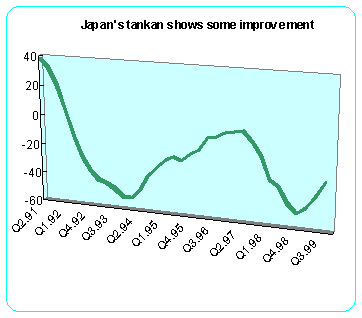
Indicators continue to show recovery...
Europe
Euroland
September economic sentiment was a mixed bag with industry confidence improving but consumer confidence remaining unchanged. The overall European Monetary Union economic sentiment indicator rose to 103.7 from 103.5 in August.
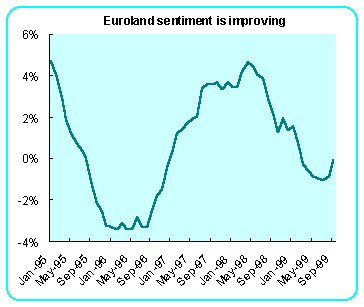
Overall economic sentiment rose firmly in France, was unchanged in Spain, but it fell back slightly in Germany and Italy, showing a persistent gap in the pace of economic growth between these two halves of the overall economy.
The seasonally adjusted unemployment rate in the 11 member states of European Monetary Union remained unchanged at 10.2 percent in August. The result indicates that the labor market in the euroland is still not benefiting from improving economic conditions. Spain had the highest unemployment rate (15.7 percent), followed by France (11.0 percent), Finland (9.9 percent), Germany (9.2 percent) and Belgium (9.1 percent). Austria had the lowest unemployment rate, 4.3 percent.
France
August industry prices for semi-finished goods rose a seasonally adjusted 0.2 percent on the month but fell 1.2 percent on the year. Industrial energy prices shot up 3.3 percent on the month and 18 percent on the year.
Consumer confidence reached an all time high in September, surpassing most forecasts, thanks to an improvement in households' outlook for living standards. Among the five composite index components, the outlook for living standards and recent living standards both rose. By contrast, the recent personal finances index slipped while the outlook for personal finances stabilized after recent gains.
Germany
Although September seasonally adjusted net unemployment rose 9,000, the unemployment rate fell to 10.1 percent from 10.3 percent. The decline was due to seasonal factors; however economic growth is still not strong enough to boost jobs and reduce unemployment significantly. The data show that Pan German unemployment data continue to show a two track economy - with joblessness down in the west but up in the east.
August's jump in manufacturing orders in August was much higher than anticipated, giving a boost to both domestic and euroland economic recovery expectations. Seasonally adjusted manufacturing orders rose 5.1 percent in August when compared to July. Special factors also had a role in the unexpectedly strong rise in orders. Much of the pickup in orders was attributed to foreign, rather than domestic demand. Foreign orders jumped 8.1 percent on the month and domestic orders rose by 3.3 percent when compared with July levels.
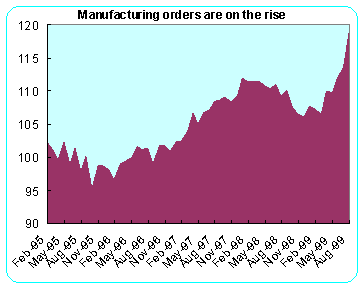
August industrial production rose 1.1 percent on the month. It now appears that production is finally beginning to catch up with increases in orders. However, August data for both industrial output and manufacturing orders have to be interpreted cautiously due to the unusual pattern this year of summer holidays, which were concentrated in July and not in August, as is generally the case.
Spain
July nonseasonally and workday adjusted industrial output rose 3.4 percent on the year. The data confirm production is steadily improving from lows earlier this year.
Britain
September retail sales volumes showed the sharpest increase in two years according to the latest Confederation of British Industry distributive trades survey. The survey's sales volume balance for September rose strongly to 41 percent - just short of retailers' expectations of 44 percent. This compares with August's balance of 33 percent and a balance of 14 percent in September last year. Retailers are expecting further strong growth in October, with the sales expectations balance standing at 43 percent.
Manufacturing output continues to show signs of revival. In August, the amount produced by manufacturing industry grew by 0.4 percent when compared with the previous month. Industrial production as a whole, which includes the volatile energy sector as well, also grew by 0.3 percent in the month. But over a longer three month period, industrial production was up 0.9 percent, and higher than one year ago.
Housing starts in the three months to August fell a seasonally adjusted two percent compared with the previous three months but were up two percent on a year earlier. Total completions in the three months to August rose by eight percent on the quarter and were up one percent on the same period a year ago. New construction orders in June to August fell six percent on the quarter and ten percent on a year earlier. Overall construction new orders in August rose 13 percent from July but because of the high March figure the quarterly comparison suffered and orders were down six percent on the previous three months. The Bank of England Monetary Policy Committee watches the housing market closely.
Asia
Australia
Australia's unemployment rate rose to a seasonally adjusted 7.4 percent in September from 7.2 percent in August. Employment rose 12,600. The number of people employed full time rose by 8,000 while the number of people in part time employment rose by 4,600.
Business conditions improved in the third quarter to their strongest level since early 1995. All components of National Australia Bank's index of business conditions improved significantly in the third quarter. Business conditions improved most in the economy's strongest sectors, including the retail and residential construction sectors. Consistent with strong trading conditions, forward orders and capacity utilization increased in the third quarter. Stronger export growth due to improved Asian economies and increased consumption ahead of the introduction of 10 percent goods and services tax in July 2000 have boosted business conditions.
Japan
Wholesale sales in September were flat and down 1.3 percent on the year. The export price index was up 0.5 percent on the month in terms of contract currencies but in yen terms it fell 2.9 percent on the month and 14.3 percent on the year. Overall wholesale prices fell 0.5 percent from July, and fell 4.4 percent when compared with a year earlier. The 1.3 percent fall in domestic wholesale prices in September when compared with last year was the 19th straight month of declines.
Americas
Canada
September employment rose by an estimated 64,000, bringing gains so far this year to 173,000 jobs. The job growth resulted in a 0.3 point drop in the unemployment rate to 7.5 percent - its lowest level since June 1990. September's job growth was all in full time work. The number of employees in the private sector increased by 74,000, bringing gains over the past three months to 143,000. This recent strength follows a five-month downward trend and leaves the number of private sector employees only slightly above its level at the beginning of the year.
Financial Markets
World Equity Markets
Equity markets can get back to business and concentrate on third quarter earnings reports now that the central banks have decided interest rate policy at least in the short term. World equity markets closed last week on the upside after interest rate fears subsided when the central banks did not raise their base loan rates. Instead, it appears that the Banks are content to let the markets raise rates for them.
| Selected World Stock Market Indexes |
| Index | 8-Oct | 1999
High | 1999
Low | Week %
Change |
|---|
| Asia |
| Australia | All Ordinaries | 2897.10 | 3145.20 | 2804.80 | 0.13 |
| Japan | Nikkei 225 | 18062.18 | 18357.90 | 13232.70 | 7.06 |
| Hong Kong | Hang Seng | 13112.42 | 14506.74 | 9076.33 | 0.62 |
| S. Korea | Korea Composite | 839.41 | 1027.93 | 498.42 | 0.01 |
| Europe |
| Britain | FTSE 100 | 6199.40 | 6420.60 | 5770.20 | 4.41 |
| France | CAC |
4721.93 | 4745.48 | 3958.70 | 3.99 |
| Germany | XETRA DAX | 5419.26 | 5652.00 | 4668.50 | 4.49 |
| North America |
| United States | Dow | 10649.76 | 11209.80 | 9120.70 | 3.67 |
| Canada | TSE Composite 300 | 7116.00 | 7292.70 | 6180.30 | 2.66 |
| Mexico | Bolsa |
5282.96 | 7292.70 | 6180.30 | 5.97 |
Europe
The FTSE (Britain), DAX (Germany) and CAC (Paris) all posted sizeable gains last week but faltered on Friday. Both the FTSE and DAX were up about 4.5 percent on the week while the CAC was not far behind - up four percent.
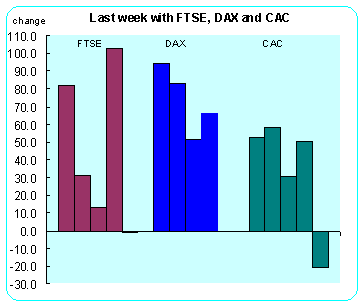
Asia
The Nikkei benefited from a stronger than expected tankan survey and a weakening yen while South Korea managed to stay level on the week despite the continuing problems surrounding the Daewoo bankruptcy debacle. The Australian market breathed a sigh of relief when the Royal Bank of Australia did not raise interest rates last week.

Currencies
The dollar posted gains against the yen and euro this week.
Euro
The euro closed at 1.061 euro on Friday, down about one percent from the prior week's close. The decline came after the European Central Bank did not raise interest rates. The euro reached a two month high last Wednesday after a larger than expected increase in German factory orders boosted speculation the European Central Bank might raise interest rates making euro deposits more attractive.
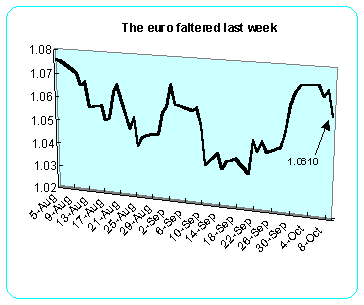
Pound sterling
The pound sterling continued its impressive performance against the U.S. dollar and the euro last week. With the central bank meetings behind them, the currency markets are shifting to indicator watching once again. British exporters are increasingly concerned about sterling's strength and how it could impede accelerating manufacturing growth. Now, the strength of the pound is attributed to expectations that the Bank of England will raise interest rates at its November meeting to ensure that faster economic growth doesn't fan future inflation.

Asia
Yen
The yen eased against the dollar and the euro on speculation once again that the Bank of Japan would yield to political pressure and increase the supply of yen in order to weaken the currency's value. The Bank's Monetary Policy Board meets on Wednesday.
Why U.S. investors care...
The equity markets breathed a sigh of relief when the central banks did not raise interest rates. This will keep borrowing costs low and permit continued business expansion here and abroad. A wider spectrum of investment opportunities in an increasing number of Asian and European economies are becoming available for savvy market participants.
Looking Ahead
|
Central Bank Policy Committee Meeting |
| Oct 13 | Japan | Bank of Japan Monetary Policy Board Meeting |
The following indicators will be released this week... |
| Europe | | |
| Oct 11 | UK | Producer Input and Output Prices (September) |
| Oct 12 | UK | Retail Price Index (September) |
| EMU | Producer Price Index (September) |
| Germany | Trade Balance (August) |
| | Final Consumer Price Index (September) |
| France | Preliminary Consumer Price Index (September) |
| Oct 13 | UK | Claimant Count Unemployment (September) |
| Germany | Retail Sales (August) |
| Oct 15 | France | Current Account (July) |
| Italy | Industrial Production (August) |
| Asia | | |
| Oct 15 | Japan | Bank of Japan Monthly Report |
| | Current Account (August) |
North America | | |
| Oct 15 | Canada | Consumer Price Index (September) |
| Mexico | Industrial Production (August) |
Release dates are subject to change.
For U.S. data releases, see this week's Simply Economics.
|








